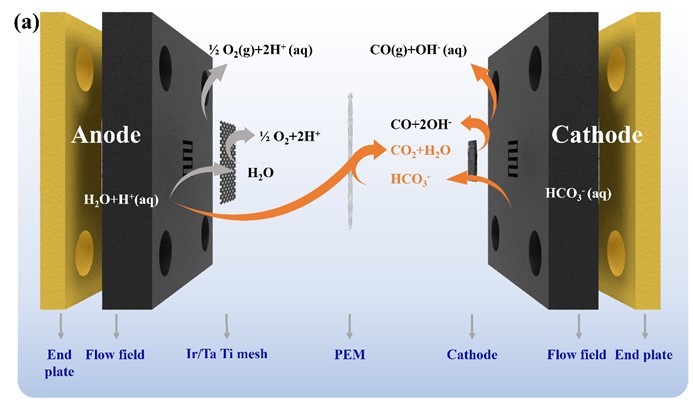Linghui Konga, Min Wanga*, Yongxiao Tuob, Shanshan Zhoua, Jinxiu Wanga, Guangbo Liu, Xuejing Cuia, Luhua Jianga*
a Nanomaterials and Electrocatalysis Laboratory, College of Materials Science and Engineering, Qingdao University of Science and Technology, 53 Zhengzhou Road, Qingdao 266042, P. R. China
b State Key Laboratory of Heavy Oil Processing, College of New Energy, China University of Petroleum (East China), Qingdao, Shandong 266580, P. R. China
* Corresponding author. E-mail address: wmin@qust.edu.cn (M. Wang); luhuajiang@qust.edu.cn (L. Jiang)
ABSTRACT
Combination of CO2 capture using inorganic alkali with subsequently electrochemical conversion of the resultant to high–value chemicals is a promising route of low cost and high efficiency. The electrochemical reduction of is challenging due to the inaccessible of negatively charged molecular groups to the electrode surface. Herein, we adopt a comprehensive strategy to tackle this challenge, i.e., cascade of in situ chemical conversion of to CO2 and CO2 electrochemical reduction in a flow cell. With a tailored Ni–N–S single atom catalyst (SACs), where sulfur (S) atoms located in the second shell of Ni center, the CO2 electroreduction (CO2ER) to CO is boosted. The experimental results and density functional theory (DFT) calculations reveal that the introduction of S increases the p electron density of N atoms near Ni atom, thereby stabilizing *H over N and boosting the first proton coupled electron transfer process of CO2ER, i.e., *+e–+*H+*CO2→*COOH. As a result, the obtained catalyst exhibits a high faradaic efficiency (FECO ~ 98%) and a low overpotential of 425 mV for CO production as well as a superior turnover frequency (TOF) of 47397 h–1, outcompeting most of the reported Ni SACs. More importantly, an extremely high FECO of 90% is achieved at 50 mA·cm–2 in the designed membrane electrode assembly (MEA) cascade electrolyzer fed with liquid bicarbonate. This work not only highlights the significant role of the second coordination on the first coordination shell of the central metal for CO2ER, but also provides an alternative and feasible strategy to realize the electrochemical conversion of to high–value chemicals.
Keywords: S doped Ni–N–C single atom catalysts; CO2 electrochemical reduction; DFT calculations; membrane electrode assembly; reduction of bicarbonate
https://doi.org/10.1016/j.jechem.2023.09.024
相关报道链接:https://mp.weixin.qq.com/s/ni0XdzsXEl3ZrBdXgO5GtQ



